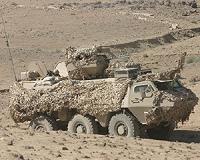| . |  |
. |
Tel Aviv, Israel (UPI) Aug 31, 2010 Military leaders and analysts are at odds over Defense Minister Ehud Barak's recent decision to buy 20 Lockheed Martin F-35 stealth fighters, largely because it will take four years for them to be delivered and become operational, too late for any assault on Iran. Israel's army and navy have expressed opposition to the air force using so much of the defense budget on the new Lightning II jets rather than on other military projects. Israeli Finance Minister Yuval Steinitz has led the criticism of Barak's plan, which would cost at least $2.75 billion-$3 billion although the price is likely to rise considerably over the next four years. However, the financial outlay could be cushioned. Israel would be able to use a sizable chunk of the nearly $3 billion in military aid it gets from the United States every year to pay for the F-35s. The U.S. weekly Defense News says Lockheed Martin was prepared to give Israeli defense companies up to 180 percent of the cost of the deal, way above the 40-100 percent usually handed out when foreign states buy U.S. weapons systems. Lockheed Martin has also said that if Israel does buy 20 F-35s it would give Israeli companies production contracts worth $4 billion for production of the aircraft, Israel National News.com. said. Barak's Aug. 15 announcement followed many months of intense negotiations between Israel's Defense Ministry, the Pentagon and Lockheed Martin over purchasing the fifth-generation, radar-evading jet -- also known as the Joint Strike Fighter -- or advanced-model Boeing F-15 Eagles. The F-35, which U.S. Defense Secretary Robert Gates has hailed as 'the backbone of U.S. air superiority for the next generation," will give the Israeli air force "the best capability in the short and long range and allow Israel to maintain aerial superiority" in the Middle East, Barak said in a statement. He made his decision despite major setbacks in the F-35 program, including a 2-year delay in development and an ever-rising cost. Development costs have grown by one-third, to $60 billion, over the last few years. Right now, sources at the Defense Ministry in Tel Aviv say it will cost Israel around $135 million per F-35, making it the most expensive aircraft ever bought by the Israelis. But analysts, among them Yiftah Shapir of the Institute for National Security Studies at Tel Aviv University, say the price may well rise to $150 million per plane before the aircraft are delivered. "The (delivery) dates have been put back all the time," he said. "First it was 2012, now maybe 2014. The development stage is not completed." Shapir, voicing the concerns of many defense specialists, argues that the F-35 is less maneuverable than Lockheed Martin's F-16, of which the Israelis have some 102 advanced-model F-16I Sufa variants, and to have a limited payload. However, the F-35's radar-evading capabilities would be a vital requirement for a long-range strike mission against Iran. Shapir conceded that the F-35, with its advanced technology, gives Israel "prestige" and by far the best fighter in the region. But, he asked, "does this mean this is the plane to stand up to the threats that Israel faces? It's a difficult question that right now has no answers." Yossi Melman, a veteran security commentator close to Israeli intelligence, also has misgivings, particularly with regard to Israel's concerns about Iran's nuclear program and possible Israeli action against the Islamic Republic's nuclear facilities. "When those planes arrive they will have no use," he argued, even if the Israeli air force fast-tracked pilot training for the new jets. Current intelligence estimates say Iran could go nuclear in 3-5 years and when that happens, Melman says, "it will be too late to bomb Iran." Israel initially wanted to buy 25 F-35s, with an option for 50 more later, but had to cut that back to 20 because of the ballooning cost. The F-35 was designed with major exports in mind. It is being developed in partnership with eight U.S. allies, including Italy, Turkey and Australia, which had been expected to buy 730. Lockheed Martin originally envisaged a production run of around 5,000 but as costs escalate and potential buyers trim their planned purchases, 3,000 is now being seen as a more accurate figure.
Share This Article With Planet Earth
Related Links The Military Industrial Complex at SpaceWar.com Learn about the Superpowers of the 21st Century at SpaceWar.com
 Estonia set to buy 80 APS
Estonia set to buy 80 APSTallinn, Estonia (UPI) Aug 27, 2010 Estonia has announced plans to buy at least 80 armored personnel carriers from the Netherlands. The Defense Ministry in Tallinn said the deal involved Sisu XA-188 version vehicles and that a contract would be signed in the coming weeks. The vehicles are currently owned by Dutch defense forces. The vehicles are intended to continue "mechanizing the 1st Infantry Brigade and to offe ... read more |
|
| The content herein, unless otherwise known to be public domain, are Copyright 1995-2010 - SpaceDaily. AFP and UPI Wire Stories are copyright Agence France-Presse and United Press International. ESA Portal Reports are copyright European Space Agency. All NASA sourced material is public domain. Additional copyrights may apply in whole or part to other bona fide parties. Advertising does not imply endorsement,agreement or approval of any opinions, statements or information provided by SpaceDaily on any Web page published or hosted by SpaceDaily. Privacy Statement |